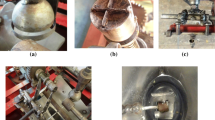Abstract
A Sugarcane juice extractor having 3340.95–4635.3kg per day cane crushing capacity was designed and fabricated as one of the equipment of the indigenous sugar processing plant recently developed in Nigeria by the National Cereals Research Institute, Badeggi. The equipment is made up of the juice extractor units, cane inlet and baggasse discharge chutes, juice collector, power transmission unit, covers and frame. The machine was fabricated with about 95% local materials in the Agricultural Engineering workshop of the Institute. Test results of the machine using sugarcane varieties BD 95-030, BD 96-009 and local chewing cane indicates juice extraction efficiency of 72.53–83.9%. It was also found suitable for extracting juice from varying cane sizes and simple to operate and maintain.
Similar content being viewed by others
References
Amosun, A., Gbabo, A. and Wada, A.C. (2000). Open Pan Sugar Processing Technology: An option for developing Countries.Sugar Tech (2). June 2000 India
Anonymous (1988). Laboratory manual on sugarcane and sugar Analysis Nigeria Sugar Company Ltd. Bacita, Nigeria. 4–28 Nov. 1988. pp 7–15.
Anonymous (1999).Nationally Co-ordinated Research Programme on Sugarcane, National Cereals Research Institute Annual Research Review Meeting, Badeggi, Nigeria. 20–23 April 1999. pp. 50–51
Busari L. D. (1999).Project profile and viability appraisal for the NCRI 10 TCD Brown Sugar Processing Plant. National Cereals Research Institute, Badeggi, Nigeria. Pp3.
Fry, J (1997). Global perspective of the Sugar Industry. Pp.1-16. In: Intensive Sugarcane production: Meeting the challenge beyond 2000.Proceedings of the Sugar 2000 Symposium, Brisbane, Australia, 20–23 August 1996.
Gbabo, A. (1991). Design and Fabrication of a centrifuge for Separating Sugar Crystal and Palm oil. A Research project submitted to the Department of Agric. Engineering, University of Ibadan Nigeria Sept. 1991.
Juvinal, R. C (1976). Engineering Consideration of Stress, Strain and Strength. Mc. Graw Hill Company, NewYork
Kaplisky, R. (1984). Sugar Processing: The Development of a third - world Technology;Intermidiate Technology Publications 1984, Pp. 13 Oxford University Press, Delhi.
Mathur, R. B. L (1993). Composition of cane juice. Hand book on cane Sugar Technology. Mohan Privailin, 66 Sapath, New Delhi, India.
Naidu, K. M (1981). Potential yield in Sugarcane and its utilization through varietal improvement Pp 1–17 In: Sugarcane Varietal Improvement.Proceeding of the International Symposium on Sugarcane Varietal Improvement. Sugarcane breeding Institute, Combatore, India.
Ryder, G. H (1982). Strength of Materials. Mc. Millian Press Limited, London.
Web, C. (1982). Shafts in Alloy Steel. The internal Nickel Company Limited. Thomas House, London.
Author information
Authors and Affiliations
Rights and permissions
About this article
Cite this article
Gbabo, A. Development and testing of sugarcane juice extractor. Sugar Tech 4, 103–107 (2002). https://doi.org/10.1007/BF02942690
Published:
Issue Date:
DOI: https://doi.org/10.1007/BF02942690




